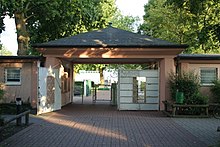Moscow bath
The Moskaubad is a public swimming pool in the desert district of Osnabrück . It was opened as an outdoor swimming pool named Moscow in 1926 . After it was renamed Neustädter Freibad in 1933, the pool was given back a small swimming pool and its old name during extensive renovation and renovation measures at the end of the 1990s . The combined indoor and outdoor pool is visited by around 250,000 guests every year. Today it is operated by the Osnabrück municipal utility .
history
Planning for the bathroom began in 1925. The central element was the grandstand that ran parallel to the 100-meter pool. The women's pool, the family pool and a non-swimmer area were also separated. The ten-meter diving platform was a special attraction. There was a preheating basin behind the grandstand. After only a few months of construction, the outdoor pool was officially opened on August 7, 1926. It was one of the city's first public recreational facilities at the time. The population quickly accepted it, and on September 5, 1926, the first visitor record was set with 10,000 guests.
The towers on the edge of the grandstand were not completed until later. In 1933 the outdoor pool was named Neustädter Freibad . In the run-up to the 1936 Olympic Games in Berlin, the swimming pool was divided into two 25-meter and one 50-meter pools. In cold winter weather, the pools were used as an ice rink until World War II . The bath was badly damaged during the war. The bombs were mainly aimed at the railway line near the swimming pool. An air mine brought down the diving platform. After the war, the British military government had the bathroom restored, and from August 1947 it was usable again.
In the 1990s, the increasingly dilapidated and technically obsolete state of the outdoor pool made extensive renovation work necessary. After lengthy construction work it was reopened in 1997 with a largely redesigned bathing facility. For example, the pool was redesigned and the former ten-meter diving platform was replaced by a three-meter and one-meter diving system. In addition to the swimming pools, there are attractions such as a 76-meter water slide , a wave pool and a rain grotto. In 1998 a small swimming pool with a 25-meter Vario pool and year-round outdoor pool was put into operation. During the construction of the swimming pool, a bomb from the Second World War was encountered, which was defused without incident.
Origin of name
Opinions differ on the origin of the name Moscow . According to a widespread version, it is derived from a coffee house "Moscow", which was located in the area of today's swimming pool in the 19th century. Some also consider a connection to Napoleon's retreat from Russia in 1812 to be possible. Another origin is suspected in Moscow as a Low German name for "mossy meadow". The fact that prisoners of war from Russia had to do their work in the desert during World War I is most likely not related to the name of the Moscow baths, since the name Moscow appeared on a map from 1880 at the current location of the swimming pool. To this day, locals say that someone goes “to Moscow” or “to Moscow” to visit the baths.
Web links
Individual evidence
- ↑ Ludwig Hoffmeyer, Ludwig Bäte, Heinrich Koch: Chronicle of the city of Osnabrück . 4th edition. Meinders & Elstermann, Osnabrück 1982, ISBN 3-88926-004-7 , chap. VI. 7. "Commercial relationships", p. 389 f .
- ↑ Measurement table sheet “Preußische Landesaufnahme” from 1880, available at kleks-online.de/editor/
Coordinates: 52 ° 15 ′ 49.5 " N , 8 ° 2 ′ 11.7" E
